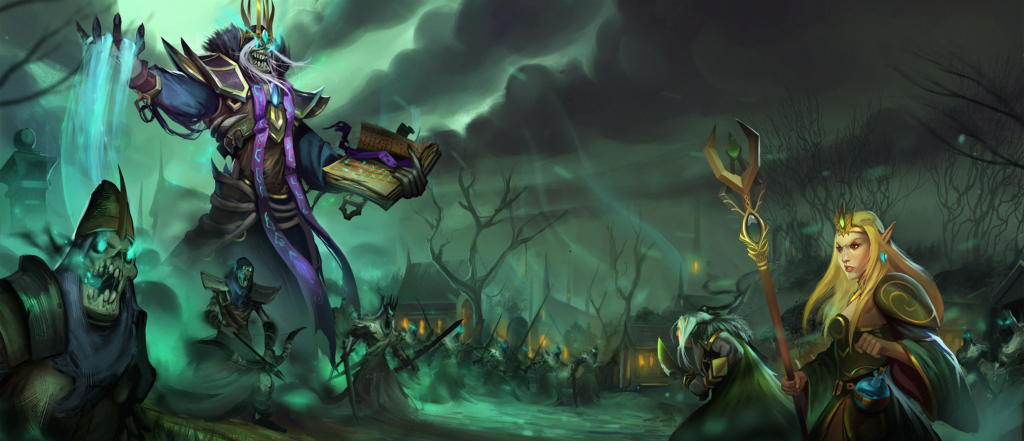This article is based on an interview with Mauro, CGS’s lead developer, during which he talked about storytelling in board games.
Worldbuilding is everything. Whenever you create a game that has a strong storytelling component, it is necessary to develop a world that can accommodate the stories within its grasp. The story alone is just not enough; it is a mere piece of a bigger puzzle that comes into place only when you envision the whole picture. Once you begin the worldbuilding process, you start to unfold the way that world was created, map out the aspects of that world, its rules, who lives in it, what kind of societies evolved, how they interact, what people believe in, what their motivations are, and what they want to achieve. As you tackle these questions and have the different characters interact with both the world and each other, the stories emerge.
I like to take a part of history that I’m interested in or that I think would pose an entertaining inspiration for what I want to create within a board game and then start adding fantasy elements to it. What would this particular culture be like if its people had, for example, access to magical abilities? How would it influence historical events? How would it change everyday life? Just try and see what can be developed from that starting point. I like to start with pieces of history as a foundation because it makes building compelling scenarios more approachable, and the end result often feels very realistic.
As soon as the world is well established, once it feels alive with dynamic relationships, the stories will just come to you. As you think about the people – what they do to fulfill their wishes and their desires inside that world – conflicts emerge, and plots unfold one after another. What if there is blood magic besides the widely accepted standard form of magic? What if that blood magic is forbidden? Maybe there is a specific group of people whose culture, religion, and social customs rely on it. Maybe they even have a representative in a grand council that, as a majority, now oppresses these people, trying to drive them away from the realm. How do you, as a member of that despised society, go on about your life? What if there isn’t anything wrong with blood magic? What if there is just a lot of corruption going on in the council? Who do you find as allies? When you add something like this together, you don’t even have to think much for different narratives to emerge. Good worldbuilding cements the foundations for stories to be told. You cannot have a good story without a good world, and bad worldbuilding won’t let you have a lot of good stories because the options of what that world can reliably offer will be too narrow.

Have you ever played a game where the story, as interesting as it might be, felt like cushioning put in just to introduce the next encounter? As if the story was just a bridge between the fights, without any extra function? When developing a game, the relationship between the overall story and the positioning of the active gameplay encounters is crucial to make both the story and the gameplay matter. To give the appropriate sense of significance to the story, it is necessary to establish the narrative as paramount, while the gameplay encounters simply become the means to achieve the objectives set out within the storyline. A fight with a huge monster would be, in this case, one of the things the protagonists need to do in order to eventually reach a positive climax of the story. The key aspect here is that the progression of the storyline dictates the need for an encounter at a specific point and for a specific reason. That encounter is then what happens along the way, not because fighting is the main objective but because it is unavoidable for the current progression of the plot.
When you start the process of developing the game from a coherent story, you can then easily identify the points that require, or would benefit from, a gameplay interaction. This is a very different approach to, let’s say, deciding first that you need 20 gameplay sessions or scenarios and then trying to mold the story to fit this arbitrary number. It may not fit, and the delivery of the narrative between those sessions will likely feel forced. If you put the needs of the narrative first, you might end up with maybe 12 gameplay sessions instead, but they would be integral to the narrative because the story would dictate where these encounters should be.
Adding gameplay sessions for the sake of having them will inevitably hurt the coherence of the narrative. If storytelling is the primary aim, the gameplay encounters are there to enrich the story. This establishes a sense of purpose in players, as they will feel that they are playing the game to achieve a clear goal or to overcome an obstacle that appeared along the way.
That being said, the storytelling part and the actual gameplay time need to be balanced so the whole experience that players will get is engaging. Fully developed lore, together with a well-written story, might easily manifest in a huge amount of text, and so there is a danger of imposing too heavy a cognitive load on players, especially if they are supposed to read long passages that are not interrupted by play. People get bored; they get tired of reading. At the same time, if you limit the storytelling only to the times between the active gameplay, you will deprive yourself of many opportunities to deliver the story. There is usually a lot to tell during a chapter, so it is wise to allocate relevant narrative as well as you can to the gameplay itself.
I don’t want to give you a massive reading passage followed by a long gameplay session because, eventually, you would get exhausted. It’s better to keep the players switching between the reading and the gameplay because then I can portion the delivery. Maybe there is a huge boss fight that takes 30 minutes, and so then I might want you to take a break, read a bit about what happened, how the outcome of the fight influenced the progress of the story, and prepare you for what comes next in the gameplay session.
Narrative passages can be utilized during gameplay to keep players focused and motivated. During a long dungeon to crawl through, if something significant happens, such as a huge, unique monster being summoned, that’s a great time to take a few-minute break and introduce a couple of narrative passages into the game. Remind the players what the monster is. Even throw in a decision that will influence the way the characters will be able to deal with that monster. Get a bit of lore in and, generally, just use this time to make the fight, and the whole journey the players are going through, a bit more exciting.
In a good game, the gameplay and narrative are intertwined with each other, and they are balanced with regard to game time in order to create an entertaining and thrilling experience. The whole game then resembles a delicate dance composed of reading, decisions, gameplay, reading, fighting, gameplay, reading, fighting, decisions, and then perhaps a bit of reading again. When executed properly, each step feels meaningful, seamlessly leading into another as a part of a coherent performance.

The whole gameplay experience is created by a combination of (for the main part) two main types of narrative that appear in storytelling games. The first one is the embedded narrative that is comprised of the story and lore hardcoded into the game by the person who designed it. It is the overall narrative arc that players go through, which, even though there may be some branching and choices to be made, has outcomes that are prefabricated. If simplified enough, it could be said that this is the part of the story players read through. Opposite the embedded narrative stands the emergent narrative, which is the sum of all the complex and mostly unpredictable situations that arise as players interact with the gameplay mechanics. These are the ‘tales of gameplay’, the stories that emerge based on cards you draw, faces of dice that show, and the combination of strictly in-game mechanical decisions that players make.
There is this saying among tabletop RPG players that dice tell stories. There are exciting moments that you will remember for a long time that were not really created by the dungeon master but written by dice. It may be a critical hit when you really needed one or a horrible fail in a very unfortunate situation.
The major difference is that the tales produced through the emergent narrative were not intentionally written into the game. There might be a plethora of possibilities hiding within every gameplay situation, and the result the players end up facing will depend on the way all the different mechanics come together. It can be one of the game design aims to make a system that caters well to this kind of storytelling. These entertaining and memorable in-game events can evoke an additional layer of immersion that the whole narrative needs in order to come alive. Surely, you must have a couple of gaming stories that start with “Do you remember when…, and then this happened…!”

There’s no way around it, really. Creating a sophisticated narrative with branching storylines within the confines of a board game medium is hard and very time-consuming. Before you realize it, the whole thing can grow a dreadful tree that is completely out of proportion. There is always the possibility of simply failing this task because testing and keeping track of all the different options, triggers, and decisions gets increasingly more difficult with every new branch you add.
Building a complex branching storyline within a board game is dangerous. But it's also one of the things I like the most as a player, and it’s what I always strive to achieve as a designer. These are the kinds of stories I want to experience and tell. And I think that, as an industry, there is a potential to step up in the way the stories are told.
At first glance, telling branching stories may sometimes not even appear as that rewarding because the players will always only engage with a single branch of the story, and so they might not even realize how many different paths they left behind. However, the whole magic lies in the ability to choose which branch you will follow; it’s in the agency to shape the story, or even the whole world, in meaningful and significant ways. Branching stories produce a unique and exhilarating feeling that brings players directly into the story with a feeling that it is they, not a paragraph of text, who have the future of the characters firmly in their hands. And even if players make some objectively bad decisions, they are still writing a story of their own. And that matters.
When I play board games, I want to feel like playing a (T)RPG. This is a footprint that is heavily imprinted on me. When I approach a situation, I like to think as the character: What should I do and why? How would I deal with this situation? Can the board game even support the decision I want to make? As a designer, I aim to make games with deep stories that players can have a huge impact on through the choices they make.
Of course, there are obvious limitations to developing branching narratives because there is only a limited amount of time that can be possibly spent on creating, incorporating, and playtesting every single branch. Therefore, one of the biggest challenges often lies within the ability to dedicate enough people and time to bring the narrative towards the scope you have envisioned.
Is it then easier to make a game with a linear story? Yes and no. While the process of incorporating a linear story into a game is easier, creating a story that works really isn’t. The more linear the story is (let’s say within the scope of meaningful decision-making and branching), the less agency, at least during the narrative stages, there is left for players.
This is the general difference between games and movies. When you play a story-heavy game, you want to have enough agency to think that your choices matter. Players want to feel that their choices are relevant and that they can affect the outcome of the situations in front of them in meaningful ways.
It’s not necessarily a problem, but it is important to keep in mind that because players have less agency within a linear story, the story (and the gameplay) has to be so good that it captivates people even though they are not actively affecting the plot. In this case, it’s not really playing in the sense of influencing what happens during the story; it is rather like experiencing a book that includes active gameplay situations along the way. This leaves a much smaller margin of error in the development and implementation of a linear story.

In the end, the deciding factor when judging whether a narrative is good or bad is realizing whether it has the ability to affect people who engage with it. A good narrative makes us think, has the ability to teach us something, and forces us to question not only how we understand what’s going on in the game but also the reality around us. At the same time, the quality of the elements permeating the narrative (such as characters, the world, or the story arc) must be relatable to universal human nature. It doesn’t matter what a character is – a villain or hero, a mermaid or human. But there must be something about that character that has the ability to emotionally affect the players. Maybe it’s the character’s motivation, inner thoughts, decisions, background, mistakes, feelings, relationships, or the situation they’re in. Whatever it is, good or bad, there needs to be some quality people can relate to. This is the hardest part.
Consider myths. People developed myths in order to explain the world around them, to help themselves and others, understand fundamental events, laws of nature, and cultural customs. It became a way for societies to comprehend why things are the way they are, to touch people, and to teach them something. Even now, when we have a much deeper understanding of the world, we still use fiction, stories, myths, and archetypes to connect others with our ideas. We still use literature to evoke powerful emotions. On the other hand, the stories that fail are the ones that feel plain, that do not provoke feelings in you, and that you cannot find any connections with.
Games can tell extraordinary stories. However, as a storytelling device, compared to books, movies, or video games, board games still have vast unutilized potential to establish themselves as a firm narrative medium in the sense that playing a game could allow you to learn something about yourself, about others, about the situation that you are witnessing. To make people understand the world a little better by experiencing different events, circumstances, and perhaps some tough dilemmas. And to actually let you find yourself in these situations through the aspects of play instead of just reading about them. There are board games like this. But not nearly as many as there could be.
LMauro, more than anything else, is a storyteller. He has more than 20 years of experience creating adventures for tabletop RPG campaigns. He joined CGS to work on Chronicles of Drunagor and became the lead developer of CoD: Apocalypse and DANTE: The Invasion of Hell. Before settling within the board game industry, Mauro was a history professor, teaching children between the ages of 10-17.
I like to think that being a history teacher is really like being a wizard in Dungeons and Dragons. You read all the time and study so hard to get all this background knowledge. And then, every day, you must prepare very specific spells for the challenges that you will face, just as you prepare the activities based on the topic and the level and age of students you need to teach that day.
Mauro also owns a store focusing on Magic The Gathering. When he’s not playing RPGs, he enjoys going to the gym or playing soccer.

Did you like this article? Subscribe to our newsletter so that you don’t miss the next one!
All rights reserved ® Creative Games Studio LLC